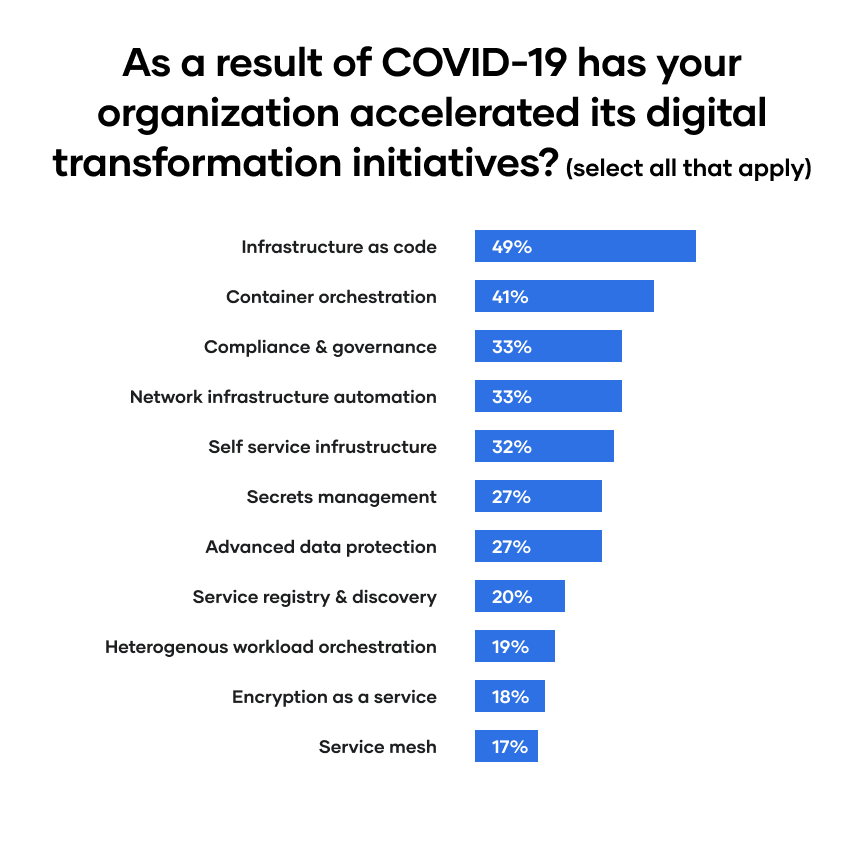How Automated Provisioning Tools Pave the Way to Multi-Cloud Adoption
The multi-cloud era has not only started — it’s already enjoying massive adoption with infrastructure as code and provisioning tools at the forefront of the movement. And those trends hold true across regions, industries, and even different levels of cloud spending.
That’s just a taste of the surprising statistics and interesting takeaways from the inaugural HashiCorp State of Cloud Strategy Survey of 3,200+ practitioners and decision-makers from the HashiCorp opt-in contact database.
In this post, we’ll take a closer look at some of the provisioning-related insights revealed in the survey, which explored the specific challenges related to the core workflows of the cloud-adoption journey: provisioning, security, application deployment, and networking.
»Provisioning Is Most Popular Category of Automation Tools
The survey showed an overwhelming share of organizations find infrastructure automation tools are critical to overcoming their cloud challenges. And provisioning was the most widely used category of infrastructure automation tooling. Roughly 90% of respondents indicated they’re either already using automated provisioning tools or will be in the next 12 months for provisioning purposes — only about 3% have no plans to use them.
Not surprisingly, perhaps, usage of automated provisioning tools was correlated with cloud spending. Approximately 65% of companies budgeting less than $100,000 in annual cloud spending already use automated provisioning tools, compared to 79% of organizations with annual cloud budgets of $2 million or more.
Regionally, it turns out that respondents in Europe/Middle East/Africa report the greatest use of provisioning automation tools (78%). Historically, the EMEA region is often seen as a “do more with less” area, where they don’t often spend big money on top-tier software licenses, instead working to fill gaps in open source software with processes and tools. And, in fact, respondents in EMEA were most likely (48% vs. 39% globally) to choose to “build on open source and run it myself” when it comes to provisioning tools. On the other hand, respondents in the Asia-Pacific region were most likely to have no plans to use provisioning tools. Additional regulatory concerns could be one factor behind this regional disparity.
The COVID-19 pandemic also impacted adoption of provisioning tools. Of the 54% of organizations that reported the pandemic accelerated their digital transformation initiatives with regards to shifts to cloud or multi-cloud adoption, infrastructure as code was the most likely area to be affected.

»Skills Shortage Is Top Provisioning Challenge
Even as adoption of multi-cloud architectures is expected to grow from 76% today to 86% in two years, key concerns remain. The most significant challenge hindering organizations’ ability to operationalize multi-cloud was a shortage of key skills, cited by 57% of respondents. Notably, the next most common response, inconsistent workflows across cloud environments, was cited by only 33% of respondents, a full 24 points behind skills shortages.

The survey also looked at cloud challenges by component, and taking a provisioning-centric view, staff and skilling issues were still the top concern, but the differences were much narrower.

Breaking the data down by industry shows the skills shortage is disproportionately impacting the public sector (25%) and retail/consumer goods industry (23%) the most.
»Open Source Provisioning Tools Are Most Popular
The survey showed that many organizations invested significant resources in their multi-cloud initiatives, including a third of respondents who budgeted $2 million or more per year (15% boasted $10 million+ cloud budgets!). Surprisingly, however, this did not always directly translate into greater spending on provisioning tools. Two-thirds of respondents use or plan to use some form of open source automation tooling for provisioning. Looked at another way, two-thirds of respondents are running their own provisioning tools instead of consuming a managed service.

The relatively sparse interest in managed service offerings becomes even more interesting in the context of the top cloud challenges mentioned above. Adoption of Software-as-a-Service (SaaS) solutions would seem to be a natural response to skills shortages, complex manual processes, and a fast-moving environment. With a SaaS approach, teams could refocus their time away from maintaining and operating their custom tooling into automating the manual processes that appear to be slowing them down.
»Learn More
A deeper look at the role of open source software and managed services can be found in our blog post on When Free Isn’t Good Enough — Why Companies Buy Infrastructure Tools, and you can read all our survey analysis here. Or go straight to the source and check out the full HashiCorp State of Cloud Strategy Survey.
Source: HashiCorp Blog
